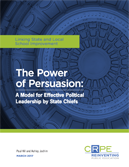State chiefs have new responsibilities under the Every Student Succeeds Act, but their formal powers are still limited. Despite these constraints, CRPE analysis finds that chiefs can make a difference by wielding their powers strategically, to build coalitions and persuade others. While turnover in the field is high, with 70% of current chiefs on the job less than two years, newcomers are taking their seats at a time of opportunity.
Drawing on interviews with current and former state chiefs, authors Hill and Jochim identify chiefs’ opportunities for influence in light of the ideas in Richard E. Neustadt’s 1960 book Presidential Power and the Modern Presidents: The Politics of Leadership. The analysis and concrete examples are intended to help current and aspiring chiefs understand how to use their authorities as the basis of bargaining, build their professional reputation, and approach decisionmaking.
Key takeaways include:
- Chiefs should fully understand their own advantages and think hard about how to bargain effectively with others in the state capital and in school districts.
- Developing new coalitions takes time and sustained attention. By pulling together broader coalitions than normally control education policy, chiefs can expand the horizons of possibility.
- To build a personal reputation for effectiveness, a chief must have and be known to have strong and specific goals to build something new or to change the status quo—and communicate them to those affected or those who may serve as a source of support.
- In order to maximize power, chiefs must approach every decision as an opportunity to strengthen their future effectiveness.
This paper is part of a series of publications from CRPE’s “Linking State and Local School Improvement” initiative, meant to inform state education leaders, policymakers, and advocacy groups about how to best support promising local school improvement efforts.





